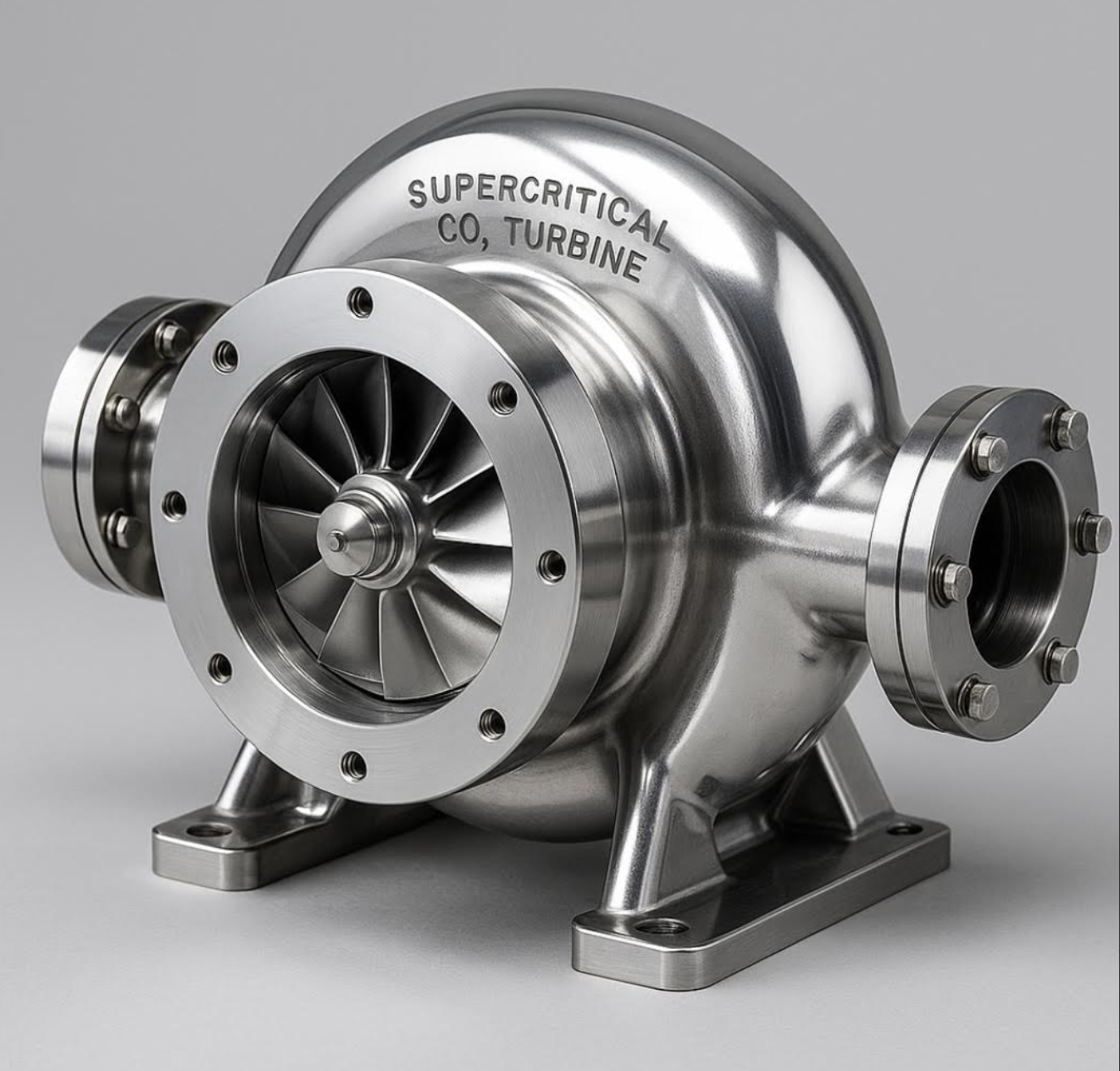

Infinity Turbine Sales | Plans | Consulting TEL: 1-608-238-6001 Email: greg@infinityturbine.com
For Data Centers Gas Turbine Waste Heat to Power Owners of Cat Solar Gas Turbine Generators and the new Boom Aero Derivative Gas Turbines Generators: Take your waste heat and make additional Combined Cycle power or generate cooling for your data center... More Info
IT250 Supercritical CO2 Gas Turbine Generator Silent Prime Power $999,000 250 kW (natural gas, solar thermal, thermal battery heat) ... More Info
IT1000 Supercritical CO2 Gas Turbine Generator Silent Prime Power $3M 1 MW (natural gas, solar thermal, thermal battery heat) ... More Info
IT50MW Supercritical CO2 Gas Turbine Generator Silent Prime Power $50M (natural gas, solar thermal, thermal battery heat) ... More Info
Data Center Consulting Prime power and energy consulting for AI and data centers... More Info
Quantum Super Turbine... Developing in 2026: High efficiency topping cycle turbine generator with bottoming cycle cooling, specifically designed for Data Centers with back-end combined cycle modules for cooling, hydraulic, or heat pump capabilities... More Info

|

|
10 MW Supercritical CO2 Turbine Generator Power Block for AI Data Centers Meeting the Power Demands of AI Data CentersThe rapid expansion of artificial intelligence requires massive computing capacity, and with it, unprecedented energy demand. Modern AI data centers not only consume large amounts of electricity but also need highly reliable, efficient, and scalable power sources. Infinity Turbine LLC is addressing this challenge with a 10 MW supercritical CO2 turbine generator power block, specifically designed for data center applications.The Technology Behind Supercritical CO2 PowerUnlike conventional steam turbines, the supercritical CO2 (sCO2) cycle operates using carbon dioxide at high pressure and temperature in a closed-loop system. When CO2 is brought to its supercritical state, it exhibits properties of both a liquid and a gas, enabling highly efficient energy conversion.Key benefits of sCO2 technology include:• Higher efficiency: Compact turbines with fewer stages compared to steam.• Smaller footprint: Ideal for data centers where space utilization is critical.• Closed-loop operation: No water consumption, making it suitable for regions with water scarcity.• Fuel flexibility: Can be powered by natural gas, solar thermal, waste heat, or other high-grade heat sources.The 10 MW Power Block ConceptThe Infinity Turbine 10 MW sCO2 turbine generator system has been engineered as a modular power block to integrate seamlessly with AI data center infrastructure.Applications include:• Backup Power: Provides a robust alternative to diesel generators or traditional gas turbines, ensuring uptime in mission-critical AI operations.• Primary Power Source: Can serve as the primary power block for data centers seeking independence from grid fluctuations or outages. Current gas turbine generator sets have a 1-2 year wait time.• Battery Charging: Efficiently charges grid-scale batteries, allowing data centers to balance load and optimize energy costs.Advantages for AI Data Centers1. High Efficiency: Achieves greater power density and lower heat rejection compared to traditional turbines.2. Scalable Design: Modular 10 MW blocks can be deployed individually or in parallel to meet multi-hundred megawatt requirements.3. Grid Resilience: Enhances data center energy security by offering reliable backup and smoothing grid integration with renewable sources.4. Versatility: Operates on multiple heat sources, including solar thermal, industrial waste heat, or natural gas.5. Sustainability: Reduces carbon footprint through better fuel utilization and eliminates water cooling demands.Strategic Impact for the Future of AIAs AI workloads accelerate, power infrastructure must evolve beyond legacy solutions. The Infinity Turbine 10 MW sCO2 power block represents a new generation of compact, efficient, and flexible systems that align with the operational and sustainability goals of advanced data centers.By offering primary, backup, and battery-charging functions in a single, scalable unit, Infinity Turbine LLC is providing a solution that empowers AI operators to meet rising energy demands while ensuring resilience, cost efficiency, and environmental responsibility.
|

|

|
|
10 MW Supercritical CO2 Turbine Generator Power Block for AI Data Centers What is the return on investment for a 10 MW power block priced at $10 million? By analyzing electricity values at $0.10 per kilowatt hour, we can calculate revenue and payback timelines that highlight the financial advantages of this scale of energy generation.IntroductionLarge-scale power generation is a capital-intensive business, but the financial returns can be significant when electricity is valued at standard market rates. A 10 MW power station offers not only a substantial supply of electricity but also rapid investment recovery under favorable pricing conditions.Revenue Calculations at $0.10 per Kilowatt HourOperating at full capacity, a 10 MW system produces 10,000 kilowatts each hour. At $0.10 per kilowatt hour, the cost savings or revenue potential is straightforward to calculate:Per Hour: $1,000Per Day (24 hours): $24,000Per Month (30 days): $720,000Per Month (31 days): $744,000Per Year (365 days): $8,760,000Payback Period on a $10 Million InvestmentWith annual gross revenue potential of $8.76 million, the capital investment of $10 million is recovered in approximately 1.14 years, or about 417 days. This translates to just under 14 months for a full payback under continuous operation.Strategic ImpactThe economics demonstrate the strength of deploying 10 MW scale power blocks for applications where stable pricing and high capacity factors can be achieved. Whether supplying a data center, grid support, or industrial demand, this size of installation can deliver rapid financial returns while ensuring long-term energy reliability. |
|
Integrating a 10 MW Supercritical CO2 Power Block into AI Data Centers IntroductionArtificial intelligence data centers are among the fastest-growing consumers of electricity, requiring reliable and efficient power delivery at scale. Traditional approaches involve generating power at medium voltage and stepping it up or down through large transformers before delivering it to servers and cooling systems. A new design approach with a 10 MW supercritical CO2 (sCO2) turbine generator power block makes it possible to produce electricity at the exact voltage required by the data center, removing the need for costly transformer infrastructure.Power and Voltage Requirements in AI Data CentersTypical AI data centers operate their server racks and supporting systems at distribution voltages ranging from 415 V to 480 V three-phase AC, or in some hyperscale environments, at higher medium-voltage direct feeds (4.16 kV to 13.8 kV) to minimize line losses before local conversion.Conventional power plants often generate electricity at lower or higher voltages than the data center consumes. This mismatch requires heavy transformers to step voltage up for transmission and back down for distribution. Each conversion adds:Capital cost of transformers and switchgearElectrical losses in the range of 2 to 4 percent per stageMaintenance overhead and added footprintBy designing the sCO2 power block generator to output directly at the data center’s required voltage level, transformers can be eliminated or drastically minimized.Cost Savings per 10 MW Block Power1. Transformer Capital Costs:Large power transformers rated at 10 MVA typically cost $500,000 to $1 million each, and redundancy requirements often double this figure. By removing the need for step-up or step-down transformers, each 10 MW block can save approximately $1 to $2 million in hardware costs.2. Electrical Loss Reduction:At $0.10 per kWh, the annual output of a 10 MW block is about $8.76 million. Avoiding even a 3 percent transformer loss equates to an additional $262,800 per year in savings per block.3. Operational and Maintenance Savings:Eliminating transformer maintenance, oil testing, and cooling equipment can reduce annual O&M expenses by tens of thousands of dollars per block.Strategic Advantages for AI Operators• Efficiency Gains: Delivering power at the correct voltage minimizes conversion steps and maximizes usable electricity.• Reduced Capital Expenditure: Avoiding transformer infrastructure lowers up-front costs and accelerates ROI.• Smaller Footprint: Freeing space previously required for large transformers allows for more servers or cooling capacity.• Higher Reliability: Fewer components in the power chain reduces single points of failure.ConclusionThe integration of a 10 MW supercritical CO2 power block directly into AI data centers at the required voltage represents a paradigm shift in how energy is delivered to high-performance computing environments. By removing transformers, operators can achieve multi-million-dollar capital savings, reduce energy losses, and improve long-term system reliability. This direct-to-load approach allows AI data centers to scale more economically while meeting the surging demand for power-hungry computation. |
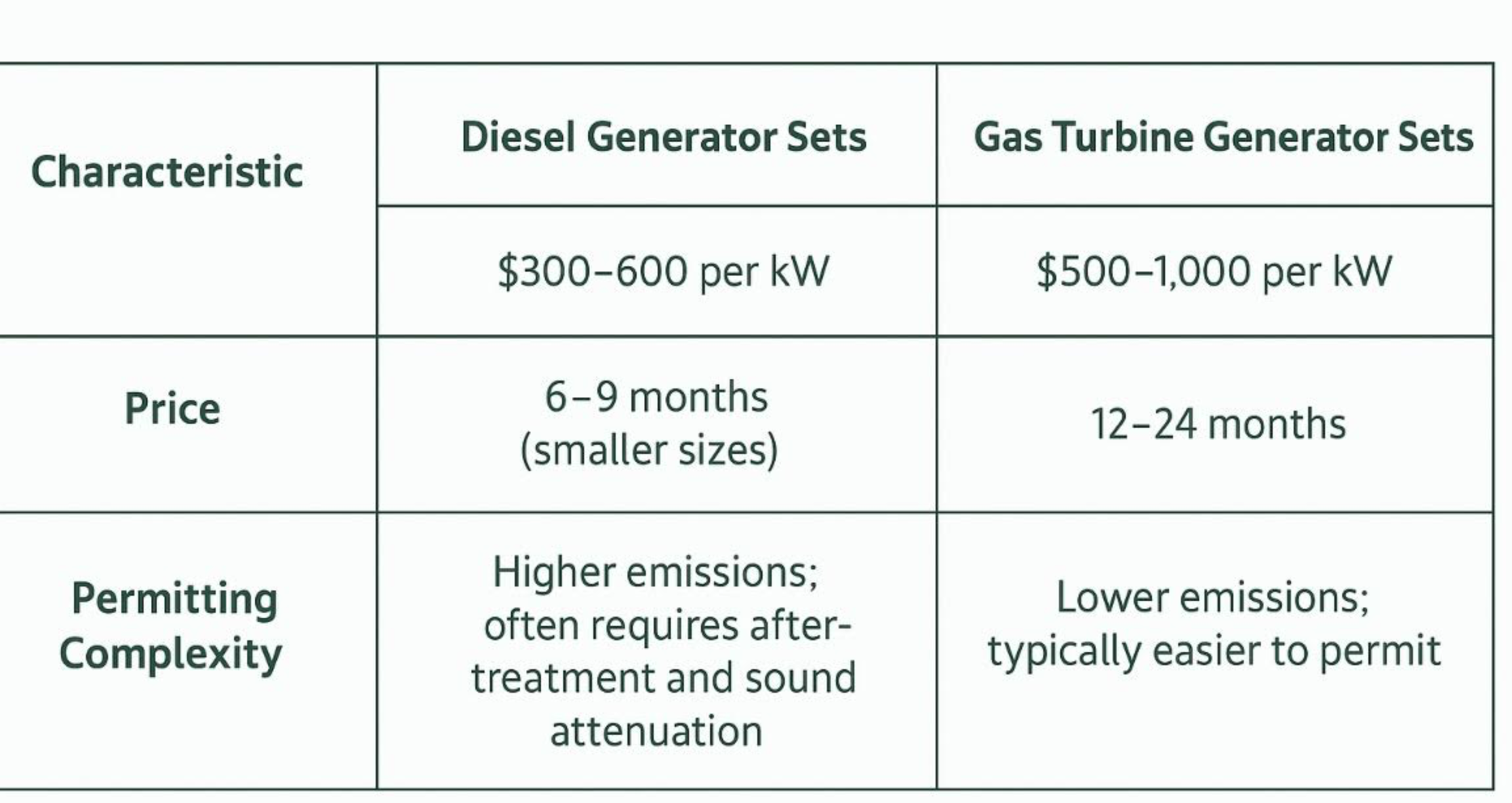
|
Price, Lead Time, and Permitting for 1 to 10 MW Gas and Diesel Generator Sets IntroductionLarge-scale backup and primary power solutions are critical for data centers, hospitals, manufacturing facilities, and other mission-critical operations. Generator sets in the 1 to 10 MW range, whether powered by natural gas turbines or large diesel engines, are in increasing demand. Price, availability, and regulatory approval timelines are now major factors in procurement decisions.Price and AvailabilityDiesel Generator Sets (1–10 MW):Prices typically range from $300 to $600 per kW, depending on manufacturer, emissions configuration, and whether the system is packaged with switchgear, cooling, and sound enclosures. A 5 MW unit may cost between $1.5 million and $3 million.Gas Turbine Generator Sets (1–10 MW):Costs are generally higher, ranging from $500 to $1,000 per kW, but these systems offer advantages in fuel flexibility and emissions performance. A 10 MW turbine package can cost between $5 million and $10 million.Current Market Availability:Due to global demand from data centers, renewable integration projects, and grid resilience programs, lead times are extending. Delivery windows of 12 to 24 months are increasingly common, especially for larger packaged turbine systems. Smaller diesel sets may still be available within 6 to 9 months, depending on inventory and supplier backlog.Permitting ConsiderationsDeploying multi-megawatt generator sets requires navigating environmental and local permitting requirements.1. Emissions:Diesel systems are subject to strict particulate and NOx regulations. Tier 4 Final compliant units are available but may require exhaust aftertreatment systems.Gas turbines generally have lower NOx and particulate emissions, but permitting can still take months depending on regional standards.2. Noise and Sound Limits:Large generators can produce sound levels above 100 dBA without enclosures. Municipal codes typically require reductions to 70 dBA or lower at property lines. Sound-attenuating enclosures and silencers are often mandatory, adding to cost and delivery time.3. Permitting Timeline:In most jurisdictions, permitting for emissions and sound compliance can take 6 to 12 months. For sensitive areas, such as near residential zones, the process can stretch longer due to public hearings or additional environmental impact reviews.Strategic Considerations for Buyers• Plan Early: Long lead times and permitting requirements mean procurement must start well ahead of project deadlines.• Evaluate Alternatives: Hybrid systems, battery storage, or smaller modular units may provide interim solutions while awaiting larger generator deliveries.• Balance Cost vs Compliance: While diesel systems are less expensive, gas turbines may offer faster permitting in regions with stringent emissions rules.ConclusionThe demand for 1 to 10 MW generator sets has created both pricing pressure and extended delivery timelines. Buyers must account not only for the capital cost but also for permitting schedules tied to emissions and sound compliance. With lead times now often stretching to one to two years, organizations should begin planning early and consider both diesel and gas turbine options to ensure reliable power availability for mission-critical operations.
|
|
Integration of Tesla Megapack for Grid Scale Battery Storage and Backup Power IntroductionThe Tesla Megapack has become a leading solution for grid scale energy storage, offering flexible backup power and energy shifting capabilities for utilities, data centers, and renewable energy operators. With demand for reliable, clean energy continuing to grow, battery systems like the Megapack are increasingly being considered as alternatives to conventional generators. However, integration at this scale requires balancing technical benefits with safety, permitting, and delivery challenges.Advantages of Grid Scale Battery Storage1. Rapid Deployment of Power: Batteries can respond within milliseconds, stabilizing frequency and providing immediate backup.2. Energy Shifting: Store excess renewable energy during peak production and discharge during demand spikes.3. Reduced Emissions: Unlike diesel or natural gas generators, batteries produce no on-site emissions during operation.4. Scalability: Modular units allow incremental capacity additions.5. Operational Simplicity: Minimal moving parts reduce routine maintenance compared to turbines or engines.Disadvantages and Challenges1. High Upfront Cost: Grid scale lithium battery systems require significant capital investment.2. Limited Duration: Megapacks typically provide 2 to 4 hours of storage, limiting their role for extended outages compared to fuel-based systems.3. Degradation Over Time: Lithium cells experience capacity fade, necessitating replacement within 10 to 15 years.Fire Hazards of Lithium-Based BatteriesOne of the most significant risks of lithium-ion batteries is the potential for thermal runaway. Once triggered, a cell can overheat and ignite neighboring cells, leading to large, difficult-to-control fires.Permitting agencies often require advanced fire suppression systems, spacing, and monitoring for early detection.Community opposition can delay projects due to safety concerns, particularly when systems are located near residential or critical infrastructure.Permitting ChallengesPermitting a grid scale battery system is complex and can involve:Fire department approvals for suppression and emergency response planning.Environmental reviews for siting, noise, and visual impact.Grid interconnection studies to ensure stability and safety when tied to transmission systems.These processes can extend timelines significantly, especially in urban or suburban regions with strict zoning and safety standards.Lead Time and DeploymentDemand for Megapacks and other grid scale batteries is high. Lead times often exceed 12 months from order to commissioning, with some projects taking 18 months or longer depending on permitting delays, interconnection requirements, and supply chain conditions. This makes early planning essential for utilities and data center operators.ConclusionThe Tesla Megapack and similar grid scale lithium-ion storage systems represent a major step toward a cleaner, more flexible energy future. Their speed of response and ability to integrate renewables provide undeniable benefits. However, fire hazards, permitting hurdles, and long lead times must be carefully managed. For mission-critical operations, Megapacks are best integrated as part of a diversified energy strategy that balances the advantages of batteries with the reliability of traditional power generation. |
|
Integrating a 10 MW Infinity Power Block with the New Tesla Megablock Energy Storage System IntroductionTesla recently unveiled the Megablock system, a pre-engineered, plug-and-play platform that streamlines the deployment of Megapack 3 battery units. Designed for utility-scale energy storage, it addresses the speed and cost challenges often associated with renewable energy infrastructure. For energy-intensive users — including AI data centers — pairing this storage system with a dedicated 10 MW supercritical CO₂ turbine generator power block yields a resilient, highly efficient integrated energy solution.Tesla Megablock OverviewThe Megablock groups Megapack 3 units into a medium-voltage battery cluster that's factory-built for faster installation — up to 23 percent faster than prior builds — and with 40 percent lower construction costs ([The Verge][1], [TESLARATI][2]). These assembled units use busbar connections to minimize field wiring, accelerating commissioning timelines.Direct Integration with a 10 MW CO₂ Power BlockWhen aligned for voltage compatibility, the power block can feed electricity directly into the Megablock system to accomplish:1. On-demand charging — the CO₂ turbine provides grid-level electric power (typically medium-voltage AC) that flows into the Megablock, whose inverters manage charging and dispatch.2. Seamless backup power — during grid outages, the power block can immediately recharge Megapack arrays, maintaining reliability for critical infrastructure.3. Energy balancing — load following from the turbine can match data center demand while Chesran stays in sync with Megablock charge/discharge schedules.Additional Advantages of Integrated Design• Higher round-trip efficiency — Tesla claims up to 91 percent efficiency from AC charging through battery in the Megablock units ([TESLARATI][2]). Direct coupling to a 10 MW power block minimizes conversion losses.• Space and infrastructure savings — factory-integrated Megablock eliminates complex transformer and switchgear fields, resulting in leaner site layout.• Rapid scalability — combined generation and storage blocks can be replicated or paralleled to scale to hundreds of megawatts with predictable performance and cost.• Resilience and microgrid readiness — the hybrid turbine-storage module can operate in islanded mode, providing stable power in grid-disrupted environments.Applications in AI Data CentersAI workloads are power-hungry and demand high reliability. This integrated design supports:• Primary power sourcing, offering consistent and clean generation.• Backup systems, eliminating conventional diesel or gas generators with faster response and cleaner operation.• Battery charging frameworks, enabling optimized storage management, peak shaving, and load smoothing.ConclusionThe Tesla Megablock and Megapack 3 set new benchmarks for utility-scale energy storage deployment. When combined with a compact 10 MW supercritical CO₂ turbine power block, the result is a seamless, high-efficiency, modular energy system ideal for AI data centers, microgrids, and other critical infrastructure. This integration enhances system performance, accelerates deployment, and supports both energy resilience and renewable transition goals. |
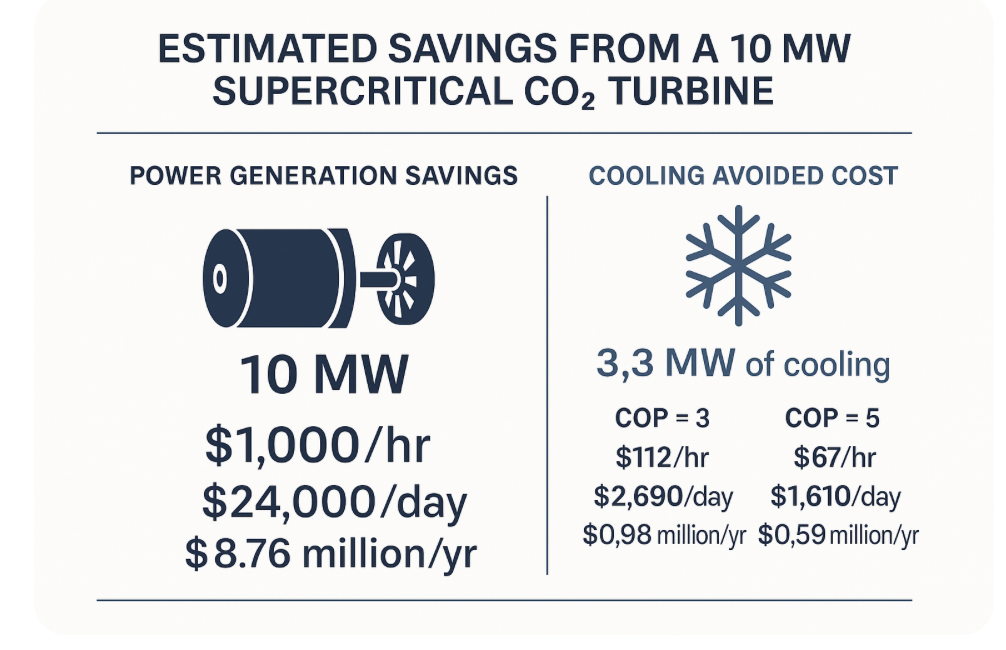
|
Free Cooling from a 10 MW Supercritical CO2 Turbine: How Much and What Is It Worth Executive summary (assumptions up front)• Plant size: 10 MW_e supercritical CO2 power block• Turbine inlet temperature (TIT): ~500 C• Cycle efficiency used for heat-rate estimate: ~45% (representative for well-designed sCO2 RCBC at 500 C)• Heat rate: ~7,582 BTU/kWh• Turbine mass flow (engineering estimate): ~66.7 kg/s (consistent with ~150 kJ/kg turbine specific work)• Post-turbine pressure letdown for cooling: from ~8 MPa to ~1 MPa via throttling (Joule–Thomson)• Joule–Thomson cooling for CO2 near ambient: ~0.8 K/bar → ~56 K drop for ~70 bar letdown• Specific heat (near ambient): cp ≈ 0.9 kJ/kg-KThese are standard, conservative design-basis values to yield order-of-magnitude results. Actual numbers depend on your exact pressures, recuperation, setpoints, and available ∆p.Cooling power available from the pressure dropUsing isenthalpic throttling (Joule–Thomson) across a suitable valve on (a) the low-temperature, high-pressure side or (b) a dedicated sidestream post-turbine:Temperature drop (∆T): ~56 KMass flow (ṁ): ~66.7 kg/sCooling capacity:Q ≈ mcp ΔT≈ 66.7×0.9×56 kW ≈ 3,360 kWIn BTU/hr: 3,360 kW × 3,412 ≈ 11,470,000 BTU/hrIn refrigeration tons:3,360 kW / 3.517 ≈ 956 tonsRange note: If your actual ∆p is lower or state point differs (e.g., slightly different temperature or pressure), expect roughly 2.5–4.0 MW of free cooling as a realistic band.What is the COP?Key point: This cooling comes from a pressure letdown that the cycle already needs; there is no additional electric compressor as in a chiller. In that sense, the effective COP is extremely high (cooling as a byproduct of a power cycle).Two useful COP views:Lower-bound COP (very conservative): Attribute all main-cycle compression work to this cooling function (even though you would incur that anyway to run the power cycle).Representative sCO2 compression work ≈ 40 kJ/kgFor 66.7 kg/s → ~2.67 MW compressor powerCOP LB ≈ Qcool/Wcomp ≈ 3.36/2.67 ≈ 1.26 COP This is an intentionally conservative, worst-case accounting.Effective COP (process viewpoint): Since the letdown is inherent to the power process, additional electric input for the cooling is near zero, so the effective COP is very large (practically free cooling). Many operators simply treat it as cooling available at negligible marginal electrical cost.Dollar value: power generated and cooling avoided cost10 MW electrical generation value (at $0.10/kWh)Per hour: • 10,000 kW×$0.10=$1,000/hr• Per day (24 h): $24,000/day• Per year (8,760 h): $8.76 million/yrCooling avoided cost (vs. running a chiller at $0.10/kWh)To supply the same ~3.36 MW of cooling with a conventional chiller, the electric draw depends on chiller COP. Two common reference COPs:COP = 3 (air-cooled typical):• Electric power needed = 3,360/3≈1,121 kW• Cost avoided: $ 112/hr or $2,690/day or $980,000/yearCOP = 5 (good water-cooled):• Electric power needed = 3,360/5≈672 kW• Cost avoided: $67/hr, $1,610/day, $590,000/yrIf your plant’s chiller COP differs, plug in your COP:Avoided cost per hour ≈ 3,360 kW / COP × $.10Context on the heat rate at 500 CWith an assumed ~45% cycle efficiency at 500 C TIT (representative for modern sCO2 recompression Brayton designs), the heat rate is:3,412 / 0.45 ≈ 7,582 BTU/kWhand thermal input for 10 MW_e is about 22.2 MW_th.Practical takeaways• A 10 MW sCO2 unit at 500 C can furnish on the order of ~3.3 MW (≈11.5 MMBTU/hr, ~950–960 tons) of low-temperature “free” cooling by exploiting the Joule–Thomson temperature drop across a designed pressure letdown.• From an accounting perspective, that cooling has an effective COP that is extremely high, because it piggybacks on pressure changes already inherent to the power cycle.• In dollar terms, the cooling avoids roughly $67–$112 per hour of chiller electricity (depending on whether your baseline chiller COP is ~5 or ~3), in addition to the $1,000 per hour of avoided electricity purchase from generating 10 MW.Notes for detailed design• The exact cooling temperature level and capacity depend on where you take the sidestream, recuperator pinch points, and the allowable ∆p.• You can increase or stage the effect with multi-step letdown or by routing a fraction of flow to match a particular cooling duty and temperature.• Always confirm Joule–Thomson coefficients and real-gas properties at your precise state points (NIST REFPROP or similar), and verify materials/phase behavior if approaching the saturation dome.Free Cooling from a 10 MW Supercritical CO2 Turbine: How Much and What Is It Worth |

|
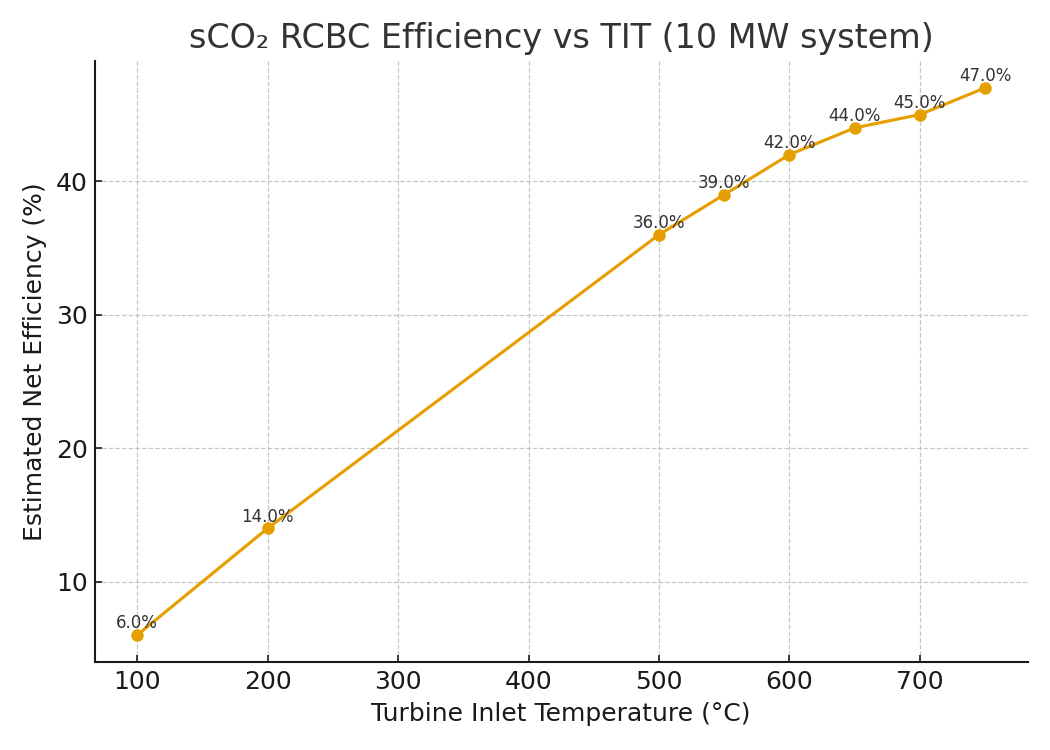
|
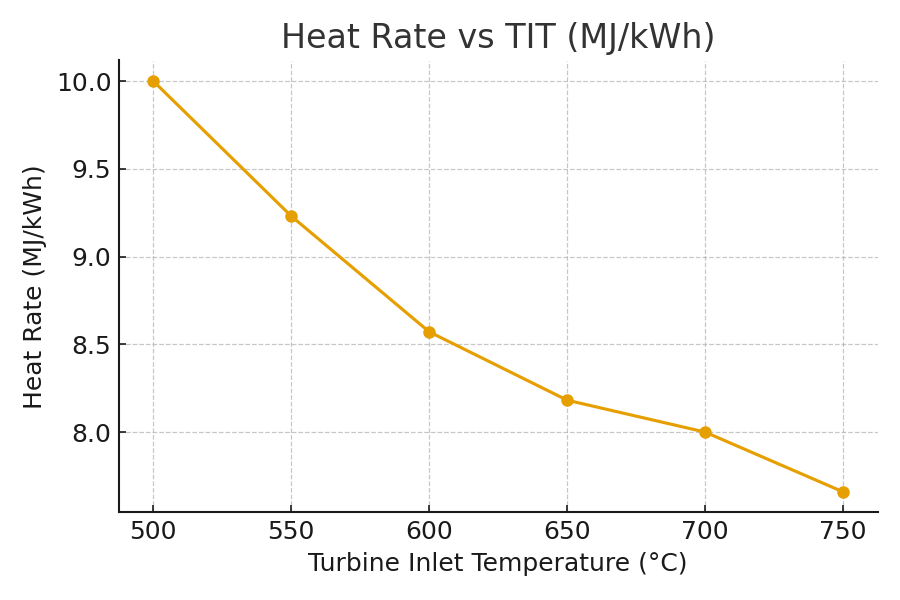
|
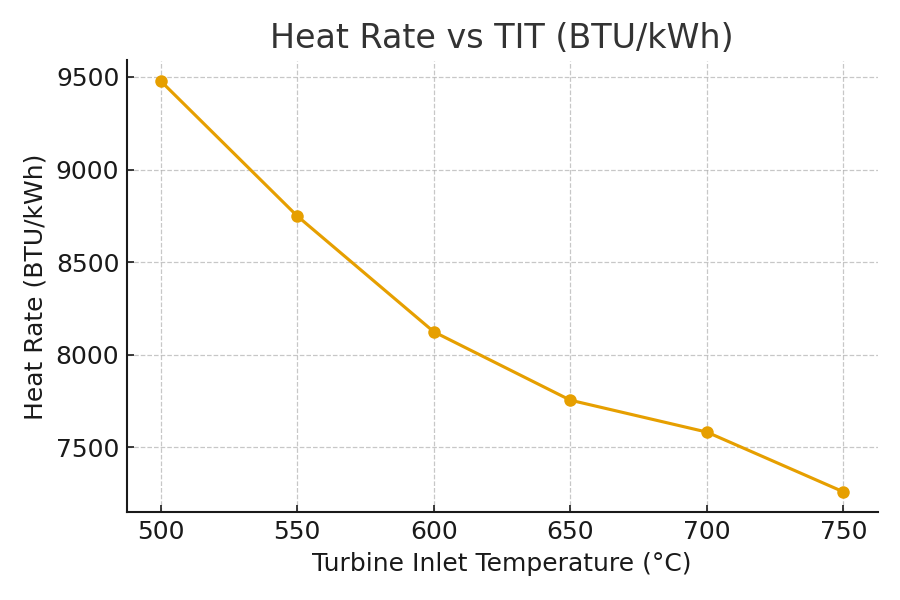
|
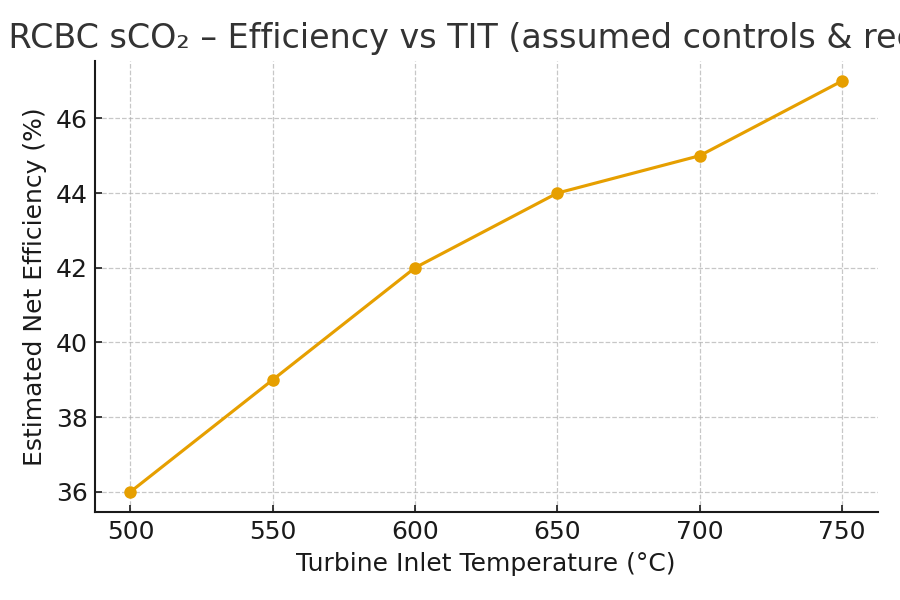
|
| CONTACT TEL: 1-608-238-6001 Email: greg@infinityturbine.com | AMP | PDF |